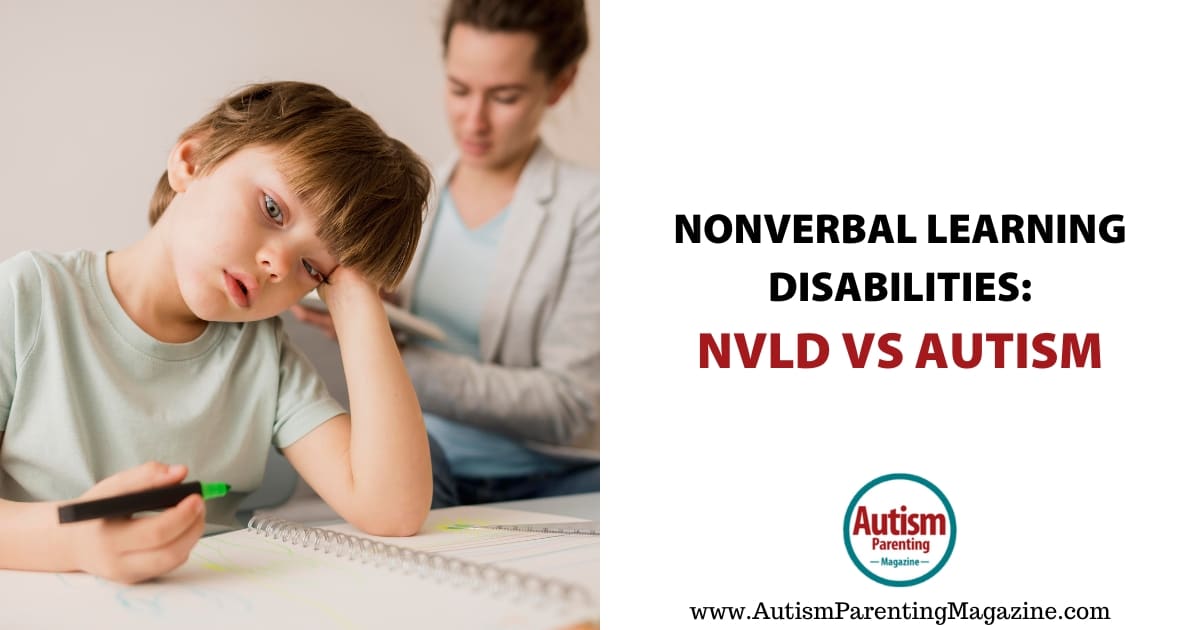Many kids struggle with everyday activities that we may find easy to do. My older son struggled to tie his shoes or do anything involving fine motor skills. This is an example of a nonverbal learning disorder. While many kids are diagnosed with these two conditions, NVLD and autism aren’t always intertwined. Autistic kids who also have a nonverbal learning disorder may have strong verbal skills, but they struggle with aspects of their lives that don’t require speech. While the two disorders may overlap, both have different criteria determining whether a child will be diagnosed with one or both. Download our FREE guide on the best Autism Resources for Parents What is Nonverbal Learning Disorder (NVLD)? In the simplest terms, a nonverbal learning disorder is a learning disability that affects several types of skills. These skills include: motor skills, visual-spatial skills, and social skills. Nonverbal learning disorder, autism spectrum disorder, and attention deficit hyperactivity disorder often have similar signs and symptoms. Nonverbal learning disorder (NVLD) has no official diagnosis in the diagnostic and statistical manual. A child with a nonverbal learning disorder may speak or write very well but struggle with nonverbal social cues and abstract concepts. Some symptoms include: Struggling to understand important concepts Reading comprehension issues Being uncoordinated Being physically or socially awkward Having messy handwriting Having concrete thinking Being oblivious to other people’s reactions Changing conversations abruptly It’s important to remember that any child diagnosed with a nonverbal learning disorder will likely experience unique challenges. NVLD vs. Autism Nonverbal learning disorder and autism spectrum disorder often have overlapping features that can make it easy for someone to confuse a diagnosis. This is especially true if someone is diagnosed with high-functioning autism. Some similarities include: Inflexibility Poor social skills Disorganization Difficulty making friends Difficulty with transitions Click here to find out more While they share these similarities, both nonverbal learning disorder and autism spectrum disorder have many differences as well. ASD children often have learning disorders, while NVLD children tend to have academic issues. Motor skills issues in NVLD children tend to involve visual-spatial organization, while those same issues in ASD children tend to be a result of sensory processing difficulties. ASD kids may be primarily visual learners, while children with NVLD may learn better by listening. It’s important to remember nonverbal learning disorders and autism spectrum disorder may use similar forms of therapy and treatment. Personal Experience My oldest son has been diagnosed with autism spectrum disorder, ADHD, and oppositional defiant disorder. However, he has also demonstrated qualities consistent with a nonverbal learning disorder. He is awkward as he struggles to recognize social patterns. He was less coordinated than his peers when playing sports. He received occupational therapy due to poor fine motor skills that led to messy handwriting. He is also inflexible and oblivious to others’ reactions when overwhelmed. When he becomes convinced of an idea, nothing will change his mind. He struggles with making friends and transitions both at school and at home. While some of this is definitely his high-functioning autism and sensory processing difficulties, I’m convinced other parts are a nonverbal learning disorder and will seek a further diagnosis. What Should You Do? It is very common for children to be diagnosed with an NVLD, and there is a definite crossover with children on the autism spectrum. This is especially true if the child is old enough to have an Asperger’s diagnosis or something similar. Parents should seek out a doctor to test their children for a nonverbal learning disability. Getting a diagnosis is important because you don’t want to treat your child for a diagnosis they don’t have. Once a child has an NVLD diagnosis, the treatments and therapies can help them recognize their tendencies and learn how to develop stronger social skills. Download our FREE guide on the best Autism Resources for Parents FAQs Q: Is NVLD considered autism? Q: Is NVLD considered autism? A: Nonverbal learning disorder (NVLD) is not considered a form of autism. While individuals with NVLD may face challenges similar to those with autism, they are distinct neurological conditions with different diagnostic criteria. Q: How is NVLD different from autism? Q: How is NVLD different from autism? A: Nonverbal learning disorder (NVLD) and autism differ in their core features. NVLD is characterized by challenges in visual-spatial processing and fine motor skills, while autism involves difficulties in social communication and repetitive behaviors. Additionally, NVLD and autism have distinct diagnostic criteria, making them separate neurodevelopmental conditions. Q: Is there a cure for NVLD? Q: Is there a cure for NVLD? A: Treatment typically addresses specific challenges and improves skills through therapeutic interventions, support, and accommodations. However, there is no standard treatment for NVLD, but a range of different ones that aim to improve different skills affected by this condition. References: American Psychiatric Association. (2013). Diagnostic and Statistical Manual of Mental Disorders (DSM-5). American Psychiatric Publishing. https://psycnet.apa.org/record/2013-14907-000 Mamen, M. (2007). Understanding nonverbal learning disabilities: A common-sense guide for parents and professionals . Jessica Kingsley Publishers. Nonverbal Learning Disability: What the SLP Needs to Know: The ASHA Leader: Vol 7, No 19 Non-verbal learning disorder: cognitive-behavioural characteristics and neuropsychological aspects https://pubmed.ncbi.nlm.nih.gov/19280579/ Rourke, B.P. (1987). Syndrome of nonverbal learning disabilities: The final common pathway of white-matter disease/dysfunction? Clinical Neuropsychologist, 1 , 209-234. https://psycnet.apa.org/record/1988-26927-001
This content was originally published here.
